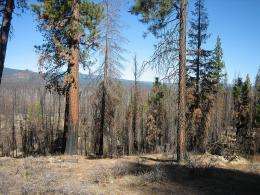Active forest management to reduce fire could help protect northern spotted owl

The northern spotted owl, a threatened species in the Pacific Northwest, would actually benefit in the long run from active management of the forest lands that form its primary habitat and are increasingly vulnerable to stand-replacing fire, researchers conclude in a recent study.
Whatever short-term drawbacks there may be from logging, thinning, or other fuel reduction activities in areas with high fire risk would be more than offset by improved forest health and fire-resistance characteristics, the scientists said, which allow more spotted owl habitat to survive in later decades.
Decades of fire suppression and a "hands-off" approach to management on many public lands have created overcrowded forests that bear little resemblance to their historic condition – at the expense of some species such as the northern spotted owl, researchers said.
The findings were published in Forest Ecology and Management, a professional journal, by researchers from Oregon State University and Michigan State University.
"For many years now, for species protection as well as other reasons, we've avoided almost all management on many public forest lands," said John Bailey, an associate professor in the Department of Forest Engineering, Resources and Management at Oregon State University.
"The problem is that fire doesn't respect the boundaries we create for wildlife protection," Bailey said. "Given the current condition of Pacific Northwest forests, the single biggest threat facing spotted owls and other species is probably stand-replacement wildfire."
In the recent project, scientists used computer models to compare what would happen to vulnerable forest lands if they were managed, or simply left alone. They found that over a long-term period of about the next 75 years, active management of sites with high fire hazard would be more favorable for spotted owl conservation.
A "risk averse" strategy in fire-prone landscapes is not the best long-term alternative to conserve protected species, they said.
As years go by, forest conditions will continue to get even more crowded, insect and disease epidemics will increase, and forests will face stress from a warmer and often drier climate. Fire levels will increase and the problem will only get worse, Bailey said.
"Without active management to reduce risks, we never really put fire out, we just delay it," he said. "We can keep kicking the can down the road, but sooner or later a stand-replacing fire will come that we can't put out. Then the fires are enormous."
Historically, Pacific Northwest forests, in both the wetter conditions west of the Cascade Range and especially the drier forests east of the mountains, were subject to higher frequency of fire, fewer trees with less overall biomass, and healthier forest conditions at a lower tree density than today. Many fires did not climb into the tree canopies and kill the tree, and even stand-replacement fires were more limited in size and scope.
A return to such conditions would significantly change the shape of modern forests, in the process producing more forest products and perhaps nurture a biofuels industry. But it would also result in less overall biomass and less sequestration of carbon, a factor in global warming concerns. The result, however, would be forests that more closely resembled their historic status and protected a wider range of species, including the northern spotted owl, Bailey said.
This analysis focused on fire-prone areas, the researchers said, and they also noted that a broad commitment to such an approach would be needed. Models suggested that more than 20 percent of a fire-prone landscape would need to be treated to begin altering fire behavior and reduce loss of spotted owl habitat.
Journal information: Forest Ecology and Management
Provided by Oregon State University


















